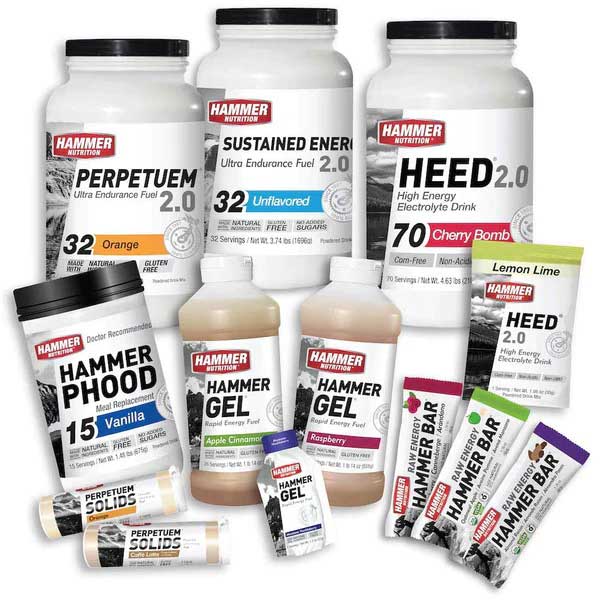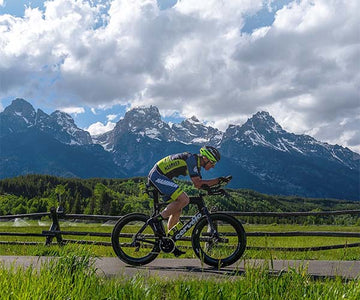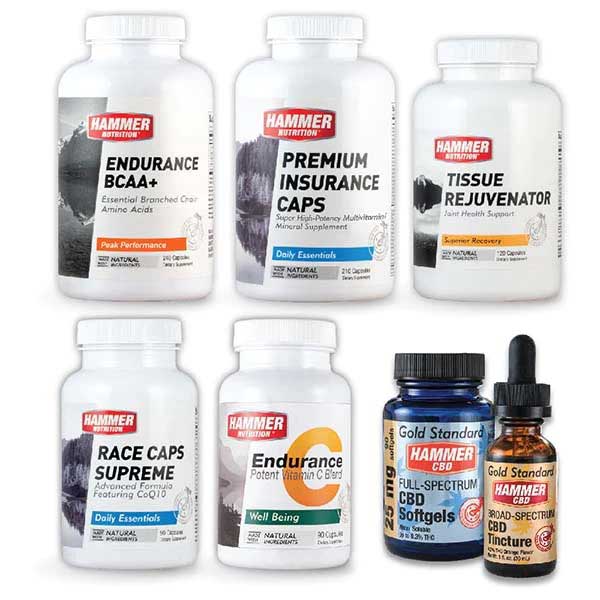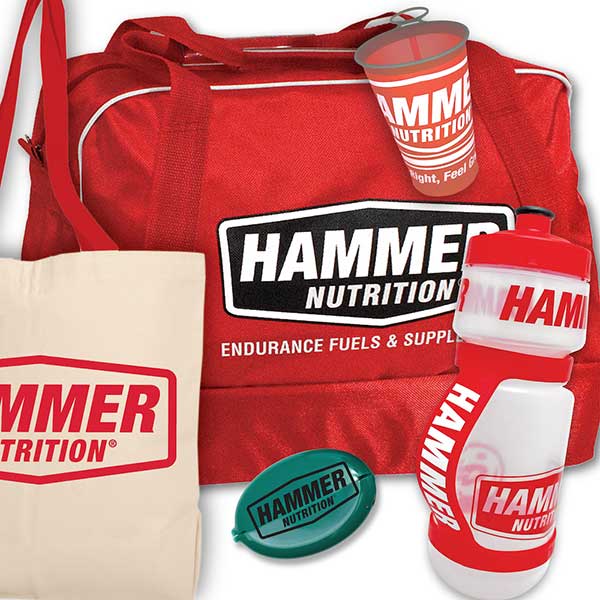Fueling for High School MTB Racing

Fuel Right, Feel Great®
BY BRIAN FRANK
This document provides the definitive fueling, hydration, and nutrition guide for riders, parents, and coaches. The information provided here is based on Hammer Nutrition’s proprietary fueling protocols developed over the past 35 years, working with thousands of athletes doing every type of endurance activity imaginable. Hammer’s fueling protocols are rooted in science and holistic nutrition and are proven in competition. These fueling protocols take all guesswork out of the equation while providing consistent, replicable performance no matter the temperature, duration, or intensity.
When it comes to fueling for endurance sports, Less is Best –
Our approach to fueling and nourishing athletes of any age entails introducing fluids, calories, and electrolytes in amounts that the body can assimilate at the optimal time. Almost all of the fueling challenges we find endurance athletes encountering during and after endurance competition come from them OVER CONSUMING one or more of the key fueling components – fluids, calories, and or electrolytes (salt).
Fueling and Nutrition Vocabulary-
Before getting into the details of how much and when, here are some definitions we should all know.
Calories – are units of measuring the heat or “energy” a nutrient can produce. (Technically, it’s the amount of heat required to raise the temperature of one kilo of water one degree Celsius.)
There are 4 calories per gram of protein and carbohydrate.
There are 9 calories per gram of fat.
Carbohydrates – include all sugars, grains, fruits, and vegetables. Carbohydrates from sugars should be minimized as much as possible at all times. Wheat products should be limited to not be the primary source of calories. Rice, quinoa, and potatoes are preferable to wheat.
The body can produce glycogen just as easily from a salad and steamed vegetables as it can from bread and pasta. Eat more vegetables all the time!
There are two types of carbohydrates – Simple and Complex; in almost every case, complex carbs are preferred.
Simple or short-chain carbohydrates (monosaccharides) include ALL sugars (anything that ends in OSE – sucrose, glucose, fructose, etc.), fruit juices, dried fruit, and highly refined grains.
Complex carbohydrates or long-chain carbohydrates (polysaccharides) include all vegetables, greens, whole fruit, and whole grains. These are favored sources of carbohydrates for athletes and non-athletes alike.
Protein – Animal source - Meat, eggs, dairy products. Vegetable sources include nuts, avocadoes, and olives. Legumes such as peas and beans offer a modicum of protein, as do all vegetables. Athletes eating a plant-based or vegetarian diet must focus on protein as a primary component of their diets.
Fat- Usually connected to protein- found in meats, eggs, dairy products, and plant sources such as nuts, olives, and avocados. Each gram of fat contains 2.5 times the calories of protein and carbs.
A balanced meal should contain good amounts of all three: protein, complex carbs, and fat.
Protein and fluid by the numbers-
Protein- Athletes should consume at least ½ gram per pound of body weight. A 150-pound athlete needs 75 grams of protein daily. If the athlete is engaging in strength training to build muscle, they must increase protein to ¾ gram per pound of body weight.
Fluids- Athletes should consume ½ ounce of freshwater per pound of body weight daily. So, the 150-pound athlete needs to consume 75-80 ounces per day. Keep in mind that this is exclusive of water/sports drinks consumed during exercise and any other beverages.
Weekday Training Meal Timing-
Goal – start every workout with little in the stomach. Eat 3 hours before riding; don’t wait until after. See pre-race meal timing for more.
Most riders will be training after school, between 3 and 6 PM. If they eat between 12-1 PM, they are ready to start pedaling 3 hours later.
If there will be much more than 3 hours between lunch and ride start, plan to have a snack prepared to eat 3 hours before.
The rider should sit down to dinner as soon as possible after completing their workout. This meal should contain ample protein, complex, and fats. If it is more than an hour between ride finish and dinner, the athlete should have some protein and carbs to bridge the gap.
Morning training rides –
IF an intrepid athlete is training early in the morning before school, they should eat breakfast immediately AFTER they finish the ride. Before brushing their teeth, have a glass of water, then fuel for the workout as normal with a Hammer Gel at the start and or a one-scoop bottle of HEED on the bike.
Eat a big, protein-rich breakfast immediately upon finishing.
Days before Race (Thursday- Friday) – It is customary and a good idea to rest the day before your race. However, it is not a good idea to “load” fluids, calories, or electrolytes!
We are not camels and cannot load fluids, but we need to replace them at the time of loss instead. So, the intake of fluids, calories, and sodium should remain constant.
Eat a balanced dinner 3 hours before going to bed. No need to stuff yourself or consume any more than usual.
Sleep –
Proper rest is the key component to recovery, and being ready to put out maximum effort during your race makes it a priority. Getting a good night’s sleep two nights before your race is the most important. Race jitter and other factors usually make it hard to sleep the night before a race. Not to worry, if you’ve slept well Thursday night, you’ll be good on Saturday.
Race Day –
The goal is to train like you race and race like you train and have a good time!! Remember that less is best, and there is no need to consume massive amounts of fuel on race morning.
Most races are one hour or less, so the pre-race meal plan is key.
Breakfast should be eaten well in advance of the race start, finishing 2-3 hours before race start, and should consist of a combination of carbs and protein, with some fat for good measure, totaling 300-400 calories.
After breakfast, sip water only or with Fizz if you like.
10 minutes before the race starts, consume the following:
- 1 serving of Hammer Gel
- 1 Endurolytes Extreme
- 4-8 ounces of water
Or
- ½ bottle of HEED
Or
- ½ Banana
- 4-8 ounces of water
Middle school and JV- For races lasting 30 minutes or so, the rider can drink water during the race or just pedal.
Varsity and Longer races: 1 to 2 hours will require calories to be consumed, roughly 100 to 150 per hour. This can easily be accomplished as follows:
- 1 serving of Hammer Gel every 45 minutes
Or
- 1-2 scoops of heed in a water bottle, depending on the duration
Or
- A banana and a bottle of water
Finish with Recoverite or a meal within 30 minutes of the day’s last event.
Early Races
Never sacrifice sleep for food. If you have an especially early race, skip breakfast altogether. After waking, continue to fast, drinking only water until you begin your warm-up or even until 10 minutes before the race starts. You may be surprised and earn yourself a PR with this plan! Be sure to practice this several times in training before doing so on race day.
Double race days
If you are racing two categories, observe the 3-hour rule between the two. If you have at least 3 hours between them, by all means, eat a meal as soon as you can after the first event. Then, repeat your warm-up and take another serving of Gel 10 minutes before your second start.
If, however, you have much less than 3 hours between races, do not eat between them. Instead, “keep the motor running” by sipping HEED or having another serving of Hammer Gel shortly after the finish and then again 10 minutes before the second race.
Meal and fuel examples:
Breakfast – egg and bacon wrap or avocado/hummus sandwich, granola with yogurt, or pancakes with banana and peanut butter on top.
Dinner – chicken breast, brown rice, steamed/sautéed zucchini/cauliflower/broccoli, and a mixed green salad.
Final thoughts:
It is always beneficial to teach the importance of food quality and on combining foods. For example, combine protein, fiber (fruit, vegetable, whole grain), and fat at almost every meal and snack. This will improve blood sugar stabilization, improve concentration for school, and, of course, help on the bike as well.
Additional Resources
5 Secrets of Success for Endurance Fueling
How To Hammer – detailed and advanced usage instructions for every Hammer product



